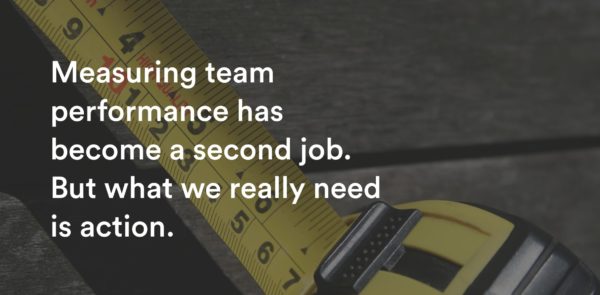Teamwork and the collaboration tools that support it are getting a lot of hype these days. And while collaboration and team-centric work approaches have proven themselves crucial to tackling the everyday challenges of modern businesses, there are also risks that come with new technology and a readily accessible team.
The same channels used for constant collaboration can become channels for unwanted distraction if used inappropriately.
Might we be flying blindly into a collaboration clusterf*ck instead of the golden age of teams? Complex problems and opportunities, diverse and dispersed teams, and prods from competition have all spurred companies to seek out a silver bullet for productivity.
But all the technology in the world won’t help if the underlying problems of working together in an environment of urgency, competition, complexity, diversity, and global distribution aren’t addressed. Without that teamwork foundation in place, we inadvertently make it harder for teams to Get Shit Done™.
With the future of work resting squarely on teams, that’s a big problem. It’s time to un-clusterf*ck collaboration. And fast.

I’ve taken on this issue as a personal challenge in my role at Atlassian, as I travel the world to observe teams and optimize how they work. To the surprise of nobody, there are patterns common amongst the best teams, and amongst those that can’t seem to get out of their own way.
Here’s what your teams are likely getting wrong, and, more importantly, what you can do to fix it.
Are you doing it wrong?
Despite the massive shift to a team-centric work approach, recent research makes it clear that some of us are still missing the mark. And the people in our teams are getting pulled in every direction. Consider that the average worker barely goes 11 minutes before getting distracted, or that they switch task every three minutes.
Further, workers spend 3.2 hours a day on average just checking emails. And 75 to 85 percent of their time is spent in meetings, which usually becomes time to furtively work on other tasks (which 73% of worker admit to) despite thinking it’s inappropriate (a belief held by 84%).
All these stats are just symptoms of greater underlying problems in how we grasp the concept of teamwork.
For one, although teams may know what they should be doing, they don’t always know why. We’ve become so focused on the process and doing things quickly that we have entire teams executing without knowing how it ties back to larger goals or how it will affect customers.
Work has become the completing of lists. The ticking of boxes. Your team members are there for a reason, but unless they understand their purpose and rally behind it, you lose out on the value they could provide.
Two, for some reason, proper teamwork got equated to having every team member chiming in on every decision until a consensus is reached. This leads to confusion and a space in which everyone is quick to critique others’ work with no individual accountability – it’s the tragedy of the commons, but with a workplace twist. Not to mention the inefficiencies.
And three, there’s too much measurement – it’s practically a second job! – and not enough action. A healthy team only needs two or three metrics to indicate whether they’re moving in the right direction, and one or two indicators for driving customer success. Overcomplicated KPIs are a classic contributor to the larger collaboration issue.

But before you throw your hands up and run off to pursue a career in beekeeping, take heart. There are ways to fix it.
Focus on the human element
Teamwork is doing the right thing, the right way, with the right people, at the right time. At Atlassian, we’ve implemented a five-step plan across more than 400 global teams to make this possible. I’ve outlined them here, along with exercises (or “plays”, as we call them) from the Atlassian Team Playbook – our open-source, no-bullshit guide to unleashing a team’s potential.

1. Get a coach. Without a leader, even the most talented bunch is just a group of people—not a team.
Ok. Useful as it is, the Team Playbook cannot help you hire a scrum master or a program manager if your company doesn’t go in for that sort of thing. That’s the bad news. The good news is that leadership is personal – not positional. Whoever you are, dear reader, you clearly care about your team/s. So perhaps you are the one you’ve been waiting for.
2. Start with the “why”: Without understanding why they’re working, a team devolves into a group executing busy-work. Make sure every team member can see how their work maps back to the larger purpose.
Whipping up an elevator pitch with your team helps solidify everyone’s understanding of the teams’ purpose. It’s also a lot of fun. To help understand the “why” behind a given project, build out an experience canvas or spend 30 minutes framing the problem you’re solving.
3. Know if your team is sick: Knowing the health of your team is critical. Each individual should know how a project is structured and how to best work together while having the support they need to fulfill their part in team success.
Three words: Team Health Monitor. This is a technique we pioneered at Atlassian, and I’ve run Health Monitor sessions with loads of teams at other companies, too. Try it. It works.
4. Just do it: Forget a 15-point plan or a year-long roadmap—just start! That is the absolute best way to build momentum. Sometimes you just have to start and piece out what is working and what isn’t along the way.
Did you know that a flow chart drawn on a cocktail napkin is a legitimate prototype? True story! Having an end-to-end demo that keeps evolving is a great way to just. bloody. do. something. Plus, iterating on your demo gives reinforces a feeling of progress and velocity amongst your team.
5. Listen and learn: Always work off team feedback. This helps build a sense of unity and an amazing sense of momentum, as kinks are worked out on the fly. Make the impact known as soon as it happens.
For structured feedback on a work in progress, take a page from the design world and try sparring (wooden sword optional). It’s a safe way for teammates to challenge each other’s ideas and push each other to deliver their best work. And of course, there’s the team retrospective – not just for software teams anymore.
“Teamwork” = “working in groups”
Teamwork does not mean constant input from all members or the abuse of productivity and communication tools. Rather, is the collaborative effort that makes complex projects possible after individuals have effectively completed their own part. Teamwork done right requires as much (if not more) individual work, concise feedback, and understanding of the broader purpose and implications.
So be honest. You haven’t been doing it right, have you?
Talk with your team and identify your weak spots (or run a Health Monitor if they’re not obvious), then use the plays I mentioned above to start building muscle. Teamwork is not a technical problem, which means technology alone can’t fix it. But with the right people, practices, and principles in place, you can un-cluster collaboration.
Start fixing BS teamwork with the Team Playbook
This piece also appears on HuffingtonPost.







































